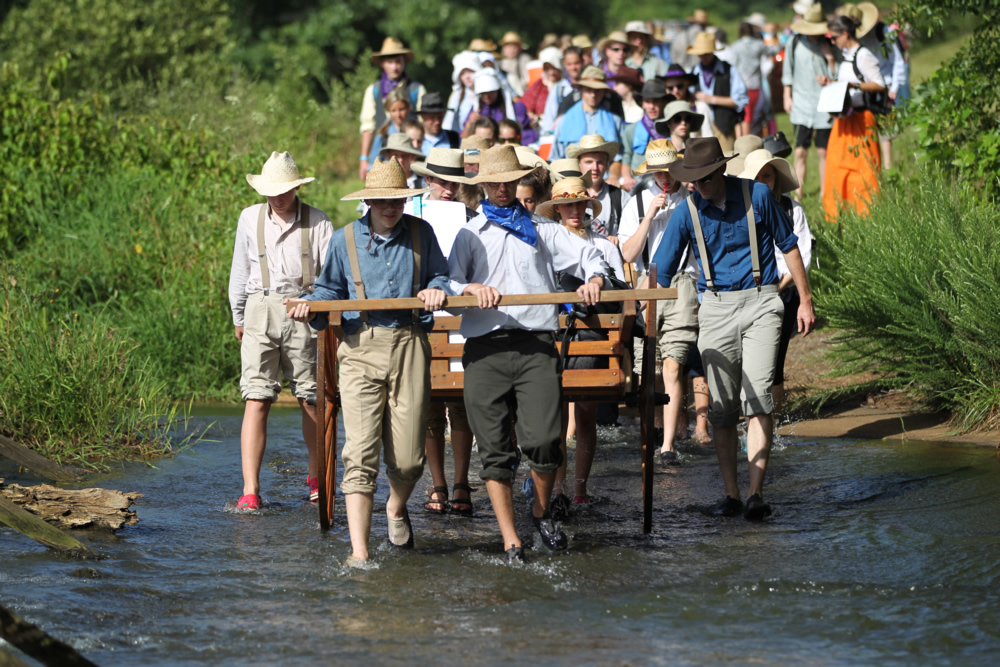 A TASTE OF THE PAST: Youth from four counties converged recently to experience life as their early Mormon forebears did in the late 1800s. They wore period clothing, and had to push and pull wagons loaded with their supplies. For more on this story, see Today’s Focus below.
A TASTE OF THE PAST: Youth from four counties converged recently to experience life as their early Mormon forebears did in the late 1800s. They wore period clothing, and had to push and pull wagons loaded with their supplies. For more on this story, see Today’s Focus below.
IN THIS EDITION
TODAY’S FOCUS: Mormon Youths Experience Their Heritage in Mountain Trek
EEB PERSPECTIVE: Why Doesn’t the USA Do Something about Reducing Gun Violence?
ANOTHER VIEW: Small Kindnesses Can Sneak Up on You
FEEDBACK: Medical Needs Are Shifting; More on Passing School Buses and Dudley-Do-Right
UPCOMING: Dance Photography Exhibit Comes to Gwinnett
NOTABLE: DAR Project Helps To Preserve Historical School Records
RECOMMENDED READ: Refund by Karen Bender
GEORGIA TIDBIT: Island in Savannah River near Augusta Is Site of Major Pottery Find
TODAY’S QUOTE: You Get What You Pay for in Medical Care
MYSTERY PHOTO: Last Mystery Was from Camden, S.C.
LAGNIAPPE: Returning to Washington
TODAY’S FOCUS
Mormon youths experience heritage in 3 days in mountains
By Mindy Durden
SUWANEE, Ga., July 24, 2015 | Recently in July, over 300 youths and leaders from the Church of Jesus Christ of Latter-Day Saints showed up on a Thursday at 8 a.m. to start their three-day journey to link them with the past. They arrived in full pioneer attire, which most of them made themselves, and a five-gallon bucket that held only the bare necessities.
The group consisted of over 245 youths from all over Forsyth, Hall, Gwinnett, Lumpkin and Dawson County. Their journey started at the Church meeting house in Suwanee, where over 100 parents and leaders had spent the last year recreating and building the city of Nauvoo, Ill. to look like it did back in the mid 1800s. Nauvoo is the city where most pioneers gathered to start their journey out to Salt Lake City, Utah.
Later that day, the youths and leaders were transported to a property near Cleveland, Ga., where they pushed and pulled wooden handcarts that were filled with all of their supplies, just the way the early Mormon pioneers did. Over the next three days, the youths were happy to walk a total of eight miles in 90 degree weather, instead of the 1,300 miles that the early pioneers walked in temperatures as cold as 10 below. The trails that the youths walked consisted of river crossings, steep hills, and many reenactments of stories that were experienced by early members of the Mormon faith so long ago.
At one point of the trek the youths were able to witness a re-enactment, that of a pioneer mother, whose small infant died on their journey. The youths watched as this mother had to say goodbye to her child and dig a small grave for him. Anna Stephenson, from the Hamilton Mill Ward, commented: “I have a baby brother that I never got to meet, and I thought about how I will get to meet him when I die.”
The air was filled with a joyful spirit so that the youths couldn’t stop smiling. People helping each other, caring for each other, and grateful that they had this opportunity.
Dieter F. Uchtdorf, Second Counselor in the First Presidency of the Church, said, “Pioneers learned that doing hard things deepened and strengthened body, mind, and spirit; magnified their understanding of their divine nature; and heightened their compassion for others.”
Today’s Mormon youths that participated in this journey endured many hardships and learned to work together to overcome the challenges that came before them. They gained a confidence that can only be achieved from overcoming hard obstacles in their life.
Ryan Howells, a leader over the trek, said, “We hope that each of these youths will have a better understanding of what some people went through just to have the simple freedom to worship how they feel. We often forget that there were many that came before us, of different religions, and gave up everything they had, including family members that they lost along the way, just to have the freedom that we so freely have today.”
In a week where the biggest subject in America was same-sex marriage being legalized, a small group of Mormon youths focused on the freedom of religion. They honored their ancestors by giving three days of their lives to live as they did and witness first hand that the freedoms we have today were not just given to them— they were earned.
EEB PERSPECTIVEWhy doesn’t this country do something to curb gun violence?
By Elliott Brack, editor and publisher
JULY 24, 2015 | Guns were the cause of two recent tragedies in the South, in Chattanooga this week, and recently in Charleston, S.C. You wonder where it will happen next. For it will.
 What we can’t understand is the continual gun violence all across the country, almost every day in big cities, while the American public nonchalantly goes about its routine activities with little effort to curb these unfortunate incidents.
What we can’t understand is the continual gun violence all across the country, almost every day in big cities, while the American public nonchalantly goes about its routine activities with little effort to curb these unfortunate incidents.
Does the American public not recognize what is causing all these problems?
Pure and simple, it’s the prevalence of guns, plus our nation’s inability to curtail the power of the National Rifle Association.
(We realize that by now we have upset the Big Gun culture. We also recognize that we may never convert these individuals to understand that it is possible for our nation to thrive without guns everywhere.)
Many gun-lovers just won’t listen to the facts. They start talking about the Second Amendment and their right to defend the country. That’s a smokescreen. They just don’t want to listen to sound reasoning, and harsh statistics. Not only that, but the right for owning guns was for these early Americans to maintain “a well regulated militia.” Today we have all sorts of officers to maintain laws, plus the military to defend our country.
 The Brady Campaign to Prevent Gun Violence reports:
The Brady Campaign to Prevent Gun Violence reports:
- On average, 31 Americans are murdered with guns every day and 151 are treated for a gun assault in an emergency room.
- Every day on average, 55 people kill themselves with a firearm, and 46 people are shot or killed in an accident with a gun.
- The U.S. firearm homicide rate is 20 times higher than the combined rates of 22 countries that are our peers in wealth and population.
- A gun in the home is 22 times more likely to be used to kill or injure in a domestic homicide, suicide, or unintentional shooting than to be used in self-defense.
Realize, too, that not only are guns deadly, but the use of firearms is getting into the pocketbook of each everyday American. Medical treatment, criminal justice proceedings, new security precautions, and reductions in quality of life are estimated to cost U.S. citizens $100 billion annually in governmental spending.
Know, too, that the lifetime medical cost for all gun violence victims in the United States is estimated at $2.3 billion, with almost half the costs borne by taxpayers.
A real problem is the 50 million handguns. Putting more teeth in the background checks (which failed in the Charleston shooting) would be a first step.
Other civilized countries find that they have less violence where guns are more controlled. In Japan, for instance, they have only 50 homicides a year from guns; in Germany, Italy and France, there are less than 150 homicides a year. Canada counts 200.
In the United States, there are more than 10,000 deaths each year to guns. Can you imagine! Over 30 a day!
And for some reason, that doesn’t upset the average American to demand more restraint on the ownership of guns. Meanwhile, the Congress, which needs to act on gun control, is muzzled by the campaign contributions and the uproar of the NRA and other gun lobbyists if they even attempt to bring up the subject. The NRA may be the most detrimental lobbying organization there is on Capitol Hill (and at the Georgia State Capitol)! They control the conversation.
Look for another outbreak of massive gun violence…any day now.
ANOTHER VIEWSmall kindnesses can sneak up on you when you least expect it
By Debra Houston
JULY 24, 2015 | On a recent Saturday, my husband and I ordered dinner at a Mexican restaurant in Tucker. Neither of us spoke thereafter, nor smiled. Our minds were elsewhere.
![]() Across the aisle, an animated young couple flirted with one another, while we, the older couple, sat static and listless. Drawn to their laughter, I’d occasionally sneak a peek, hoping their cheer might rub off on me.
Across the aisle, an animated young couple flirted with one another, while we, the older couple, sat static and listless. Drawn to their laughter, I’d occasionally sneak a peek, hoping their cheer might rub off on me.
Our dinner came and we ate in silence. We both cleaned our plates. I said, “We were hungrier than we thought.” We’d not eaten regularly or slept well for a while. Our broken hearts were on clear display. We made no pretense to disguise them.
Our neighbor and friend of 36 years had died the night before. “Died in my arms,” her husband tearfully said. Diagnosed with cancer three months earlier, she vowed to fight it. Radiation and chemo followed, but the cancer spread. Now she was gone.
During those tortuous days – and nights – we sought to ease the family’s suffering. My husband mowed their lawn frequently. We offered moral support. We prayed. We sent over a big-old coconut cake…..our acts of small kindnesses.
Her funeral was scheduled for Tuesday. We would attend, then leave directly for vacation, though it seemed insensitive to go. Her husband urged us not to change our plans. “You’ve done more than enough”…..his words, a small kindness.
Back at the restaurant, the lovebirds headed toward the door. Before exiting into the bright sunshine, they turned and gave us an intense look. “How odd,” I thought. Then the bill came. My husband reached for his wallet, but in broken English, the waitress said someone had already paid. “You owe nothing.”
“Really?” we asked, not believing our ears. “Who paid?”
She pointed to the lovebirds’ table. And then it struck me. They had sensed our grief.
Now we were the animated couple laughing and making conversation. On the drive home, we praised the two angels who had given us a reprieve from sorrow.
A small kindness? There’s no such thing. All kindnesses are colossal.
IN THE SPOTLIGHTWalton EMC
 The public spiritedness of our sponsors allows us to bring GwinnettForum.com to you at no cost to readers. Today’s sponsor is Walton EMC, which provides electric service to 70,000 Gwinnett homes and businesses in the Lilburn, Snellville, Grayson, Loganville and Dacula areas. Because its customers own the company, service — not profit — is Walton EMC’s primary focus. Walton EMC is ranked “Highest in Customer Satisfaction Among Midsize Utilities in the South” by J.D. Power (see jdpower.com for details).
The public spiritedness of our sponsors allows us to bring GwinnettForum.com to you at no cost to readers. Today’s sponsor is Walton EMC, which provides electric service to 70,000 Gwinnett homes and businesses in the Lilburn, Snellville, Grayson, Loganville and Dacula areas. Because its customers own the company, service — not profit — is Walton EMC’s primary focus. Walton EMC is ranked “Highest in Customer Satisfaction Among Midsize Utilities in the South” by J.D. Power (see jdpower.com for details).
- Contact Walton EMC at waltonemc.com, facebook.com/waltonemc or 770-267-2505.
- For a list of other sponsors of this forum, go to https://www.gwinnettforum.com/about/sponsors.htm.
Medical needs are not diminishing, but merely shifting
Editor, the Forum:
 Citing a decline in patients corresponding to the roll out of the federal healthcare marketplace, the Gwinnett Community Clinic announced recently that it will be shutting its doors after more than 25 years of providing access to primary medical care for a portion of Gwinnett County’s poor, uninsured residents.
Citing a decline in patients corresponding to the roll out of the federal healthcare marketplace, the Gwinnett Community Clinic announced recently that it will be shutting its doors after more than 25 years of providing access to primary medical care for a portion of Gwinnett County’s poor, uninsured residents.
Eleven miles away at the Good Samaritan Health Center of Gwinnett – another charitable clinic – you would find a very different reality.
Good Samaritan has seen staggering growth over the past four years – from more than 3,000 patient visits in 2011 to 11,898 in 2014. As of July 15, 2015 Good Samaritan has provided 8,600 patient visits and is on pace to provide over 16,000 patient encounters in 2015 – more than 500 percent increase in patient demand since 2011.
The Gwinnett Clinic is closing its doors due to decreased demand, yet Good Samaritan’s 4,300 square foot building is bursting at the seams. How can this be?
On Tuesday and Thursday evenings, the Gwinnett Community Clinic served uninsured adults aged 18-65 who met household income qualifications, had an appointment, and lived in Gwinnett.
Good Samaritan is open 52 hours-per-week and serves uninsured residents of the Gwinnett Metro Area aging from birth to 95 years old. Walk-ins and patients with appointments are served without a referral, proof of residency, or income caps.
Medicaid provides access for the poorest of the poor – families earning up to 37 percent of the Federal Poverty Limit (FPL). The Affordable Care Act provides insurance subsidies for those earning 100-400 percent of the FPL. There are an estimated 500,000+ Georgians in the gap from 37 to 100 percent of the FPL. We must recognize that the need is not diminishing it is simply shifting. The poorest of the poor may have access to care, but affordable care for the working poor is disappearing.
— Brian Abernathy, Buford
Suggests another way that might solve people passing school buses
Editor, the Forum:
Concerning signs about school buses, I do not believe it is a lack of signs that causes folks to pass by school buses. I believe it is ignorance of the drivers, their lack of knowledge of current rules of the road, or just plain laziness.
We teach teenagers to drive at 15 to 16 years of age. They learn enough to pass a test they take once in their lives. Rules change every year, laws are added, laws are changed and nobody seems to be aware of the new rules. I see drivers daily in the left hand lane of the Interstate and or the express lane who are clearly unaware of the new “Move over” law.
Why don’t we require the taking of a written and road test as part of the renewal process? This would force folks to at least bone up on current law every so many years. It could also add a continuing education requirement as well. Many professional and licensed professions require this as well. A road test would also help those folks who are aging and whom should no longer be driving get gracefully off of the road.
— Tim Sullivan, Buford
Dear Tim: We hear you, but anticipate complications. For instance, many people would not “bone up” on new regulations, thereby flunking their test, causing them to have to re-take, meaning more congestion at licensing stations, and more cost. Perhaps there is a better way someone can come up with. –eeb
Following Dudley Do-Right when he is elected to Congress of USA
Editor, the Forum:
We see it happen over and over. Dudley Do-Right gets elected to Congress. He is a straight shooting, honest person. He and we are proud about how straight shooting acts.
His virtues are noticed by old time members of Congress who were once straight shooters themselves. They have taken notice of him because they are getting wet by the waves he is generating and their once nicely laid out feathers have become ruffled. An old timer is assigned to Dudley to straighten out the straight shooter.
The Old Timer invites Dudley into the cloak room and says to him, “What the hell is wrong with you?”
From that point on, it is just a matter of time. Little by little our straight shooting, honest Dudley is changed into extremely dastardly Dudley.
What does all of this have to do with George Washington? Obviously this transformation would never have happened to the father of our country who never told a lie. Going along to get along is a powerful driving force in our nine percent approval rated Congress. Ole George’s honesty would have remained intact. Or would it have?
— Alex Ortolano, Duluth
Send us a letter. We encourage readers to submit feedback (or letters to the editor). Send your thoughts to the editor at elliott@brack.net. We will edit for length and clarity. Make sure to include your name and the city where you live. Submission of a comment grants permission for us to reprint. Please keep your comments to 300 words or less. However, we will consider longer articles (no more than 500 words) for featuring in Today’s Issue as space allows.
UPCOMINGDance photography exhibit comes to Gwinnett from New York
A 20-image exhibition of dance photography by Richard Calmes will be on view at the studios of Gwinnett Ballet Theatre in Lawrenceville beginning August 8,, the date an opening reception will be held at 6:30 p.m. These photographs, enlarged to be 3’x4’ in size, were selected and exhibited at the National Museum of Dance in New York from May, 2014 through May of 2015. The exhibition at Gwinnett Ballet Theatre marks the first time Atlanta audiences will have an opportunity to view the photographs as a collection.
Calmes is an internationally-known dance photographer who has gained a large audience since he began shooting dance images in 2006. His website has received over 40 million visits over the past nine years, and he has produced three books of dance images.
The National Museum of Dance contacted Calmes in 2013 regarding an exhibition at their facility located in Saratoga Springs, N.Y. The location is a popular one for dancers and dance enthusiasts as it hosts the New York City Ballet’s summer programs. These 20 images will be displayed on the various walls of Gwinnett Ballet Theatre’s 20,000 square foot facility located at 1800 Macleod Drive in Lawrenceville.
Calmes was a combat photographer in Vietnam. Later he became an architect and later a corporate executive. From his first session of photos taken for marketing purposes for Gwinnett Ballet eight years ago, he was on a definitive path.
- The public is cordially invited. For more information, contact hcalmes@mindspring.com. For information and directions to GBT, contact 770-237-0046.
DAR chapter completes project to preserve school records
Valerie Craft of Lawrenceville was looking for a way to use her talents in service. She discovered an opportunity at Tamassee, S.C. DAR School to carry out the DAR mission to promote historic preservation. Last year she visited the Tamassee DAR School, founded in 1919 to serve underprivileged children of Appalachia, to help deliver the Philadelphia Winn chapter’s donations to the Thrift Store and to take a tour of the school.
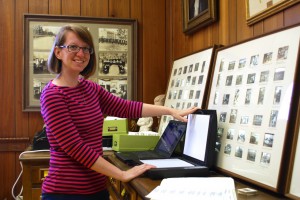 During the visit, she noticed many historic photos lining the walls of May Erwin Talmadge Auditorium. One of Valerie’s passions is preserving historic photographs, and she was inspired to propose a digitization project to preserve the school’s 95-year-old collection of historic photos and documents. Many were framed or were scattered loosely throughout drawers and cabinets and left susceptible to damage and loss.
During the visit, she noticed many historic photos lining the walls of May Erwin Talmadge Auditorium. One of Valerie’s passions is preserving historic photographs, and she was inspired to propose a digitization project to preserve the school’s 95-year-old collection of historic photos and documents. Many were framed or were scattered loosely throughout drawers and cabinets and left susceptible to damage and loss.
Philadelphia Winn Regent Lydia McGill agreed to make Photo Digitization at Tamassee the 2014-2016 Philadelphia Winn Chapter project. Valerie, who is the chapter’s Historic Preservation Committee chair, went to work. Approximately 5,000 records have now been scanned. Volunteers brought their own scanners and laptops from home and scanned each record, creating a digital file that is stored on a hard drive and was uploaded to an online storage system.
Two computers with large storage capacities and a laptop were donated by members (and husbands) of Philadelphia Winn Chapter. The Chapter also purchased archival boxes and safe storage materials for the originals. After many days of work by Chapter volunteers, the collection of original photos and records are now protected and stored in an organized system. The images are currently being organized in a digital system that will allow anyone to quickly find specific photos and documents based on names, dates, and subject matter. For many of the children who grew up at Tamassee DAR School, these are the only pictures that exist of their childhood years.
Gwinnett rolls back General Fund tax rate by 2.3 percent
The Gwinnett County Board of Commissioners on Tuesday adopted 2015 millage rates (click to see rates) to fund the services provided by county government, rolling back the general fund rate by 2.3 percent and maintaining last year’s rate for the service districts. State law requires that a rollback millage rate be computed for the general fund, that will produce the same total revenue on the current year’s new tax digest that last year’s millage rate would have produced had no reassessments occurred.
Millage rates in Gwinnett County vary based on a property’s location and what services the county provides. The total millage rate in unincorporated areas will be 13.579, down slightly from last year. Rates for three service districts will remain the same: fire and emergency medical services (3.20 mills), police (1.60 mills) and development and code enforcement (.36 mills). In addition, the countywide levy for both voter-approved debt and recreation remain unchanged at .24 and .95 mills, respectively, while the general fund rollback rate is 7.229 mills.
Action by commissioners paved the way for property tax bills for mailing by August 15 with a payment due date of October 15.
Gwinnett Tech program director named to national panel
Gwinnett Technical College Surgical Technology Program Director TC Parker has been named a member of the national Association of Surgical Technologists (AST) Education and Professional Standards Committee. In this new role, Parker will work on standards of practice policies for the profession as well as the core curriculum for accredited programs. Parker, who lives with her husband of 34 years in Grayson, was first introduced to the profession by a friend in the 1990s and developed a love of the operating room activities. Parker started her career at Northside Hospital and eventually moved to Gwinnett Medical Center where she worked as the orthopedic resource tech. After beginning at Gwinnett Technical College as a fulltime adjunct clinical director in 1999, she became the program director in 2002.
RECOMMENDEDRefund
Stories by Karen Bender
 These stories are poignant and slightly disturbing, perhaps because the author conveys so keenly what money means to some. In “Theft,” an elderly swindler books a cruise to get one last big pay off. Even in dementia, she briefly bonds with a young female passenger who asks her what she did for a living. She gamely responds, ‘I am a swindler.’ Another story, “Refund,” describes a broke couple who rent out their Tribeca apartment for $3,000 in September. It turns out to be much more costly when one of the renters dies in the 9/11 attack and the other wants a refund far beyond the original price. The book is a mesmerizing read and so true-to-life describing so well the private low level anxiety many experience today around money, including what it can and cannot buy.
These stories are poignant and slightly disturbing, perhaps because the author conveys so keenly what money means to some. In “Theft,” an elderly swindler books a cruise to get one last big pay off. Even in dementia, she briefly bonds with a young female passenger who asks her what she did for a living. She gamely responds, ‘I am a swindler.’ Another story, “Refund,” describes a broke couple who rent out their Tribeca apartment for $3,000 in September. It turns out to be much more costly when one of the renters dies in the 9/11 attack and the other wants a refund far beyond the original price. The book is a mesmerizing read and so true-to-life describing so well the private low level anxiety many experience today around money, including what it can and cannot buy.
— Karen Harris, Stone Mountain
An invitation: what books, restaurants, movies or web sites have you enjoyed recently? Send us your recent selection, along with a short paragraph (100 words) as to why you liked this, plus what you plan to visit or read next. –eeb
GEORGIA ENCYCLOPEDIA TIDBITIsland in Savannah River near Augusta is site of major pottery find
Stallings Island, a National Historic Landmark site, was a major settlement of Late Archaic Native Americans from 4,500 to 3,500 years ago. Located in the Savannah River eight miles upstream from Augusta, the 16-acre island is the namesake of Stallings Culture and its hallmark pottery, Stallings fiber-tempered wares, the oldest pottery in North America.
Stallings Island was occupied intermittently throughout prehistory. It was during the height of Stallings Culture (ca. 3,800 to 3,500 years ago), however, that the site appears to have been the population center of a hunter-gatherer society whose level of culture was more complex than that of all prior societies in the surrounding region.
The most significant archaeological deposits on Stallings Island consist of a two-acre accumulation of freshwater shellfish remains—over ten-feet thick in places—along with other food remains, myriad artifacts, pit features, and human burials.
Excavations began in the 1850s with investigations by Charles C. Jones Jr. They were followed in the 20th century by no fewer than five expeditions, most notably the 1929 project sponsored by the Peabody Museum of Harvard University in Cambridge, Mass. Illicit digging has been an ongoing cause of destruction at the site. The Archaeological Conservancy acquired Stallings Island in 1997 and strives to protect it from further damage.
Stallings Island is best known for its very early pottery, a technological development that predated the advent of farming in Georgia by several millennia. Accompanying this innovation were other indications, such as permanent architecture and storage technology, of an increasingly intensive hunter-gatherer economy. At 3,500 years ago the island and surrounding area were abandoned. Evidence for diminished health and environmental degradation suggest that the sedentary Stallings lifestyle ultimately was unsustainable. Changing relations with neighboring groups on the coast and in the uplands may have contributed to regional abandonment.
- To access the Georgia Encyclopedia online, go to http://www.georgiaencyclopedia.org
Possible creampuff, but where?
CLUE: Today’s mystery photo may be a creampuff to some travelers. So tell us where you think scene was shot, and which rail line it is. Send your ideas to elliott@brack.net, and be sure to include your hometown.
 The mystery photo in the last issue was topical, and sent in by Ross Lenhart of Pawley’s Island, S.C. The figures in the photo are of Larry Doby and Bernard Baruch, in a setting at Archives Plaza in Camden, S.C., honoring two native sons.
The mystery photo in the last issue was topical, and sent in by Ross Lenhart of Pawley’s Island, S.C. The figures in the photo are of Larry Doby and Bernard Baruch, in a setting at Archives Plaza in Camden, S.C., honoring two native sons.
John Stringer Rainey, a native of Anderson, S.C., moved to Camden in the 1970s. Best described as an unconventional Southern gentlemen, Mr. Rainey found it totally unacceptable that Camden had never chosen to honor two of her hometown heroes, and decided he was just the man to rectify the situation. He commissioned sculptor Mariah Kirby-Smith to fashion statues of two of Camden’s finest: Bernard Baruch and Larry Doby. And they named the work “Reconciliation.”
The only person getting the identification right was Ruthy Lachman Paul of Norcross. Here is what she wrote: “Larry Doby was an American baseball player in the Negro leagues and Major League baseball who was the second black player to break baseball’s color barrier. Bernard Mannes Baruch was an influential Jewish-American who made his fortune on speculation in stocks, which made him one of the leading figures on Wall Street in the early 20th century. Then he turned his attention to party politics in America, was the political and economic adviser to Presidents Woodrow Wilson and Franklin D. Roosevelt and one of the strongest people in the Democratic Party of the time.”
LAGNIAPPEState representative
Georgia’s 111 Washington Youth Tour (WYT) delegates have chosen Dacula’s Chris Larkins as the 2015 state representative to the National Rural Electric Cooperative Association’s (NRECA) Youth Leadership Council (YLC). Larkins was sponsored in the program by Jackson EMC. Larkins return to Washington, D.C. in July, along with 43 other state representatives for the week-long program. As Georgia’s representative, Larkins will also speak at Georgia EMC’s Annual Meeting, held in Savannah in November; participate in NRECA’s Annual Meeting in New Orleans, La. in February; and speak at the WYT kickoff banquet in June 2016.
CREDITS
GwinnettForum is provided to you at no charge every Tuesday and Friday. If you would like to serve as an underwriter, click here to learn more.
- Send your thoughts, 55-word short stories, pet peeves or comments on any issue to Gwinnett Forum for future publication.
- MORE: Contact Editor and Publisher Elliott Brack at: elliott@gwinnettforum.com


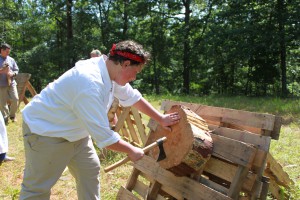
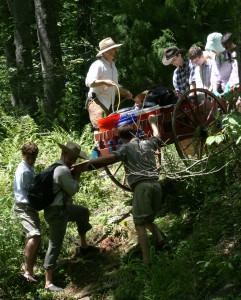


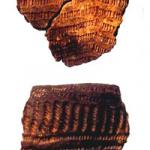

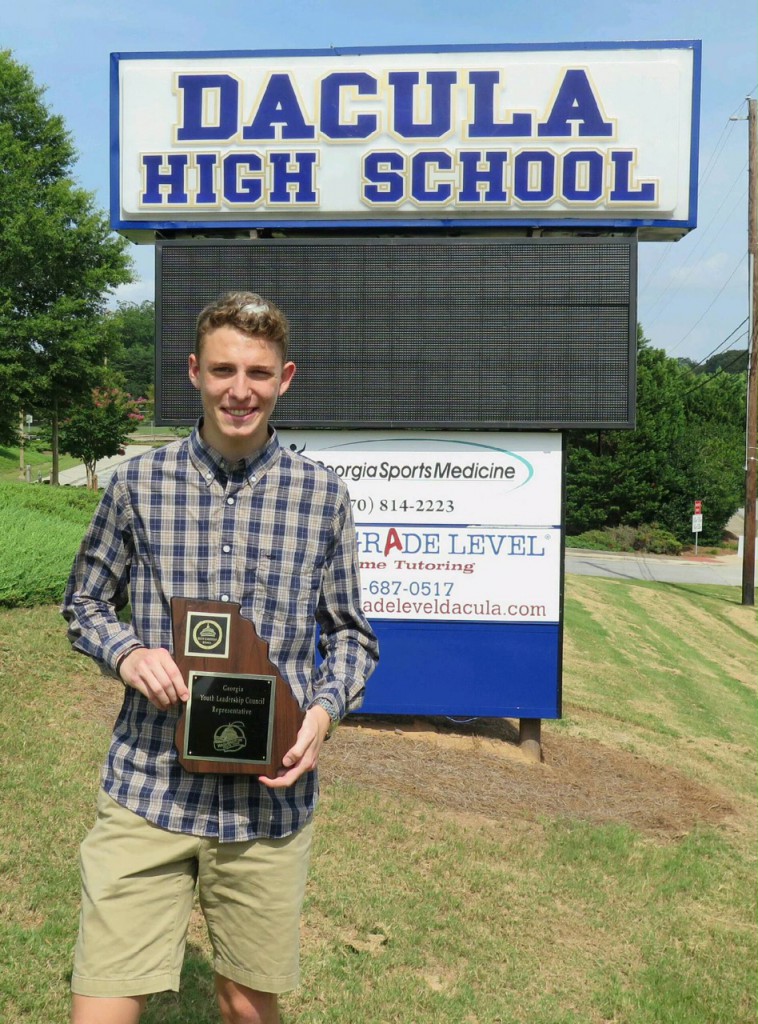







Follow Us